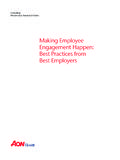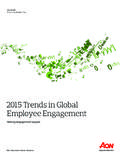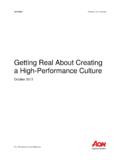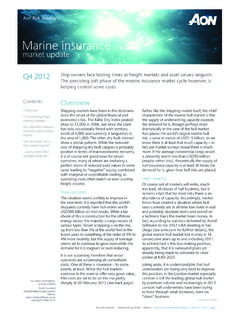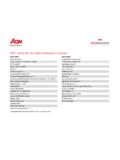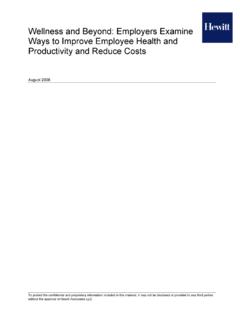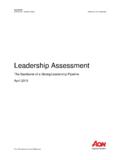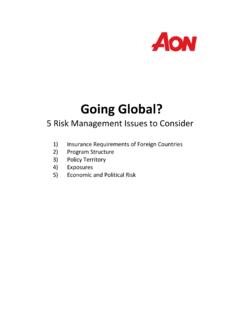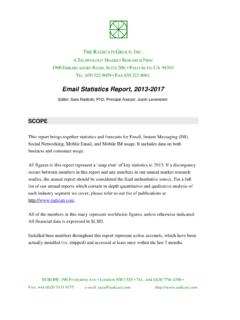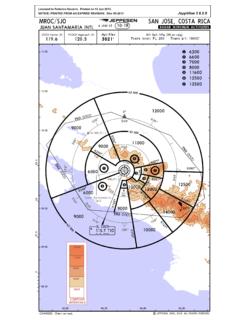Transcription of 2013 Trends in Global Employee Engagement - Aon
1 Consulting Performance, Reward & Talent 2013 Trends in Global Employee Engagement 2013 Trends in Global Employee Engagement Contents 2 Executive Summary 4 Aon Hewitt's Engagement Model 6 Trends in Global Employee Engagement 7 Elements of Employee Engagement 9 Macroeconomic Indicators, Company Performance and Individual Employee Engagement 15 Changes in the Work Experience 17 Key Drivers of Employee Engagement 20 Understanding Engagement by Segments 24 Conclusion: Seize the Opportunity to Improve Employee Engagement and Business Results 26 Appendix 2013 Trends in Global Employee Engagement 1. Executive Summary The Global recession has certainly taken its toll on employees.
2 Pay freezes, benefit cuts and layoffs are still at the forefront of many employees' thinking. Additionally, the continued high rates of unemployment, lack of hiring, and extended hiring cycles for open positions (an average of 23 business days today compared to a low of 15 in mid- 20091) create further stress and uncertainty for employees, making it more difficult to achieve or maintain healthy levels of Engagement . As markets around the world continue to display uneven growth patterns following the Global recession, predictions for 2013 are marginally optimistic but varied by region. The International Monetary Fund (IMF) predicts stronger Global growth in 2013 , driven by growth (albeit slow growth) in China, India and Brazil, and greater confidence in growth following the recent The Euro Zone predicts continued variability, with minimal expansion in Germany and France, while countries such as Italy and Spain continue to resolve their country-specific challenges from the Global economic Against this backdrop, engaging the right employees in the right behaviors remains the critical ingredient of how companies manage the diverse economic conditions facing their organizations today.
3 In our last report, we asked employers to consider an atypical question in solving the Engagement equation not what should we do to engage employees? but what do employees need in order to be engaged? In this incredible time of competing pressures demand for profitable growth, financial market volatility, political uncertainty, Global shifts in workforce demographics, sea changes in the countries driving economic expansion and a rapidly shifting regulatory environment a finer point must be put on that core Engagement question. Leaders must ask themselves not only what do employees need in order to be engaged? but also what behaviors are we asking them to engage in?
4 The ability of companies to find, understand, and manage talent hinges upon getting a powerful, differentiated and engaging employment contract right. The demands outlined above are putting pressure on this contract. Companies require steadfast motivation and productivity in this constrained environment. At the same time, dynamic Employee Trends are changing the nature of what employees demand in exchange for their discretionary effort. Striving to maintain a higher level of Employee Engagement not only contributes toward short-term survival during economic volatility, but also is a key factor for longer-term business performance and better positioning when market conditions become favorable.
5 The companies that get Engagement right can enjoy a surplus of competitive advantage in talent strategy and business results that is hard for others to replicate. If one believes that talent is one of the last sources of competitive advantage and that motivated and productive employees are the make-or-break ingredient to successfully navigating the business pressures outlined above Employee Engagement should be a top business imperative for all business leaders. 1 With Positions to Fill, Employers Wait for Perfection, The New York Times, March 6, 2013 ; references data from The Establishment-Level Behavior of Vacancies and Hiring ; Steven J Davis, R Jason Faberman and John C Haltiwanger, The Quarterly Journal of Economics; January 31, 2013 .
6 2 Modest Growth Pickup in 2013 , Projects IMF, Global Economic Outlook, January 2013 ;. survey/so/ 2013 3 Ibid. 2 Aon Hewitt Key Findings Engagement levels are on the rise globally but shifting across regions. Although the economic impact of the recession continues to rebound in some areas and recess further in others, Engagement levels rose slightly to 60% in 2012, up 2 percentage points from 58% in 2011. We see the largest Engagement increase in Europe (improving 5. percentage points) and Latin America (improving 3 percentage points). North America's Engagement decreased slightly by 1 percentage point particularly in the , where Engagement dropped 3 percentage points and Asia Pacific remained the same.
7 Worldwide, 4 out of 10 employees are still not engaged. While 60% of employees globally are considered engaged, 40% of employees are passive or actively disengaged a continuing theme from 2011. While Engagement levels are relatively stable and many employees are advocates for their employers, 2013 will likely be a challenging year as other Engagement indicators regarding employees' desire to stay with an organization and go above and beyond are less positive. Employee Engagement is a leading indicator of company growth but lags economic forces. The economic recession of 2009 put significant downward pressure on corporate spending on talent and Engagement took a significant hit in the following year.
8 The Global economy has shown signs of growth in the years since, however, and Engagement has been on the rise as well. Analysis of Employee Engagement and company performance data concludes companies that managed higher Employee Engagement relative to their peers throughout the economic downturn are now seeing dramatic, positive impacts to their revenue growth. The work experience is improving more than deteriorating. Overall Trends from 2011 to 2012 reveal more aspects of the work experience are improving, and to a greater extent than any decreasing areas. The highest area increased 7. percentage points, whereas the worst deterioration went down 3 percentage points.
9 These changes to the general work experience varied by region around the globe. Many employers across the globe raised the bar and made investments in the top Engagement drivers. In addition to seeing perceptions of the work experience increase in general, we specifically saw improvements in all but one of the top Employee Engagement drivers. These Engagement driver increases indicate many employers focused resources in the areas that are most important and have the greatest opportunity for Engagement improvement. The uptick we see in Employee Engagement is likely evidence of this focus. Pay is one of the top drivers of Engagement . Usually described as a hygiene factor of little consequence to Employee Engagement , pay moved up in Engagement driver ranking from #6 in 2011 to #3 in 2012.
10 In addition, positive perception scores of pay improved 2 percentage points from 2011. This finding has many implications for total rewards strategies in an ever-changing economic and talent landscape. Engagement drivers are not universal. Operating in the multicultural, multigenerational and cross-geographical world represents new challenges for leaders trying to drive high levels of Employee Engagement . Organizations that invest in understanding and managing the key drivers of Engagement across their multiple constituencies will drive performance in efficient, effective ways. This research report provides insight into Global Employee Engagement Trends over the last few years.
